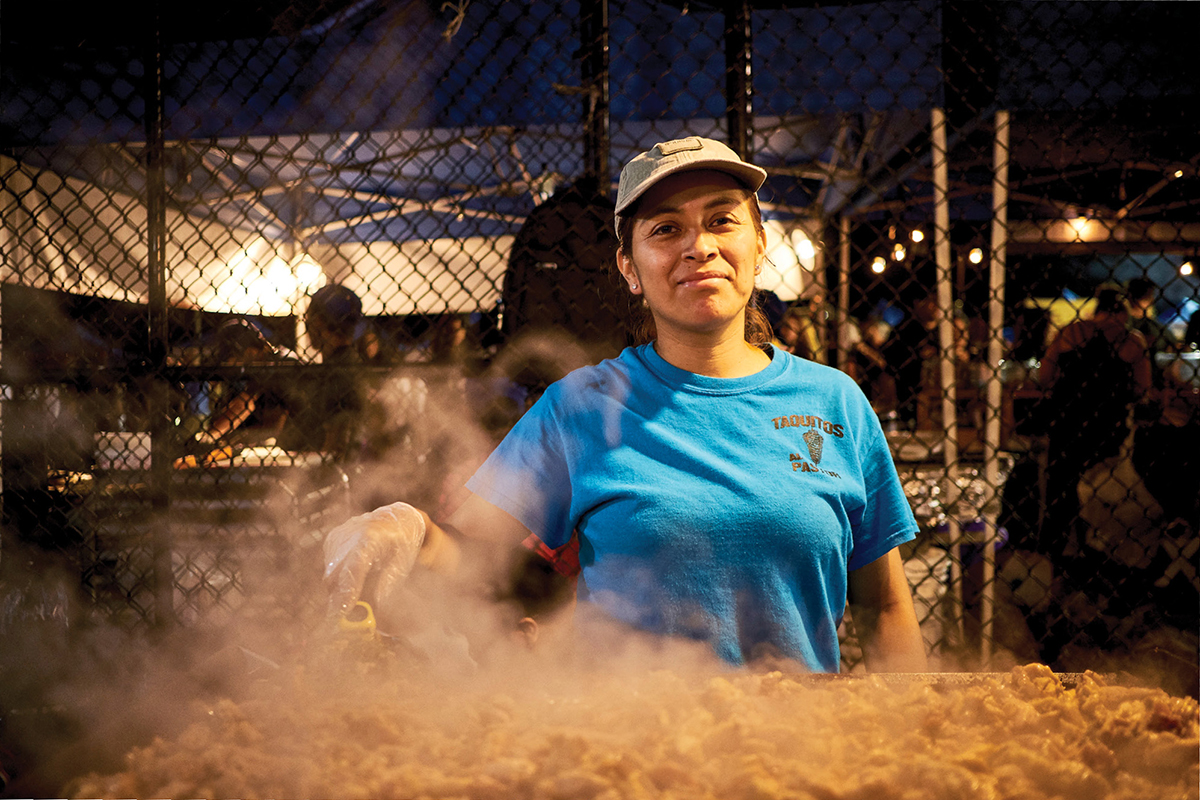
Maximina Alvarado
EL TROMPO
2
MEXICO
Growing up in the Iztapalapa borough of Mexico City, Maximina wanted to be a flight attendant—that is, until she realized she was afraid of planes.
Maximina comes from a family of business owners, and few people seem as excited and optimistic about entrepreneurship as she genuinely is. She’s even been known to give pep talks to discouraged subway vendors: Follow your dreams, keep pushing. . . . ¡Adelante!
Me ha tocado ver dos o tres amistades que tengo que venden en los trenes. Son luchadores. Hay otros que asustan, que escondan o piensan que lo están haciendo mal. Yo pienso que ellas pues sigan adelante y si no tienen el apoyo de nadie pues ellas mismas.
“I have two or three friends who sell in the trains. They are fighters. There are other people who get scared and hide or think that they are doing poorly. I remind them not to give up, and even if they don’t have support from anyone, they have themselves.”
“QUEENS NIGHT MARKET HAS TAKEN A GREAT SIGNIFICANCE FOR ME BECAUSE IT IS A PLACE TO MEET OTHER PEOPLE AND CULTURES FROM OTHER COUNTRIES.”
Maximina has been living in Queens for over ten years and loves it because the residents and the energy are always just corriendo—running. She revels in how many small businesses make up the fabric of this vibrant borough. She owns El Trompo with her husband, Modesto, and her four kids chip in where they can. The family will sometimes sit around the TV watching MasterChef, each donning gloves, and working on a new batch of salsa.
She takes pride in working hard and persevering and is extremely economical with her time, making the most of every moment. Whether she’s focused on her business or enjoying a day off at Governor’s Island with her family—she’s always “corriendo.”
Before starting at the Queens Night Market, she and Modesto ran a tiny eatery just one block away from the event. After two years of insistence, her daughter finally convinced her to apply to be a vendor. When they were accepted and started selling at the market, they would shutter their shop on Saturday nights, with a handwritten note taped to the door saying you could find them down the street, with an arrow pointing toward the Queens Night Market.
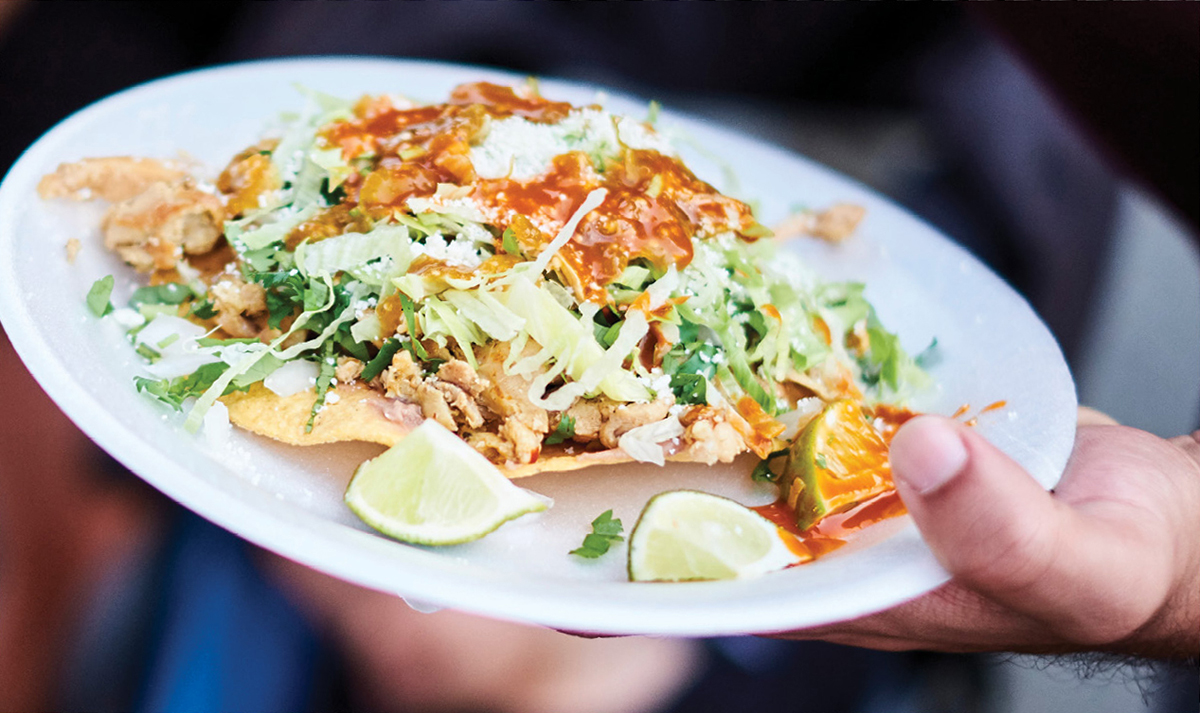
“Queens Night Market has taken a great significance for me because it is a place to meet other people and cultures from other countries. You can interact with them and know their gastronomy and crafts that maybe we did not know. It is also the opportunity for them to know a little about Mexico.”
Early in her residency at the Queens Night Market, Maximina used to make each tortilla by hand, reveling in the process of pressing each ball of nixtamalized corn to order. Then one night a friend stopped by and told her she needed to get faster. When Maximina looked up, she realized a line of dozens of hungry customers had formed, waiting for a taste of Mexico. It was one of the first times she stopped “running” and just took in the awe of the moment. It was also the last time she made each tortilla to order by hand.
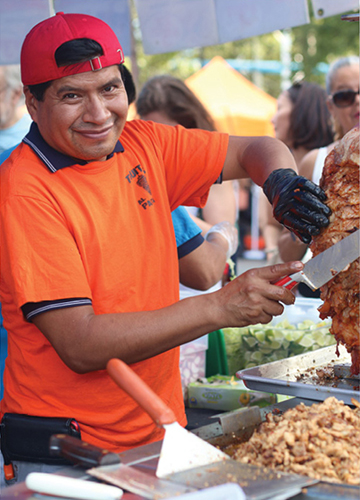
Maximina’s husband, Modesto
TACOS DE BIRRIA
Maximina began cooking birria when she first arrived in NYC and was acclimating to the new country, culture, and customs. Birria was something familiar, and making it kept her grounded and in touch with her roots in Mexico. It is traditionally made in an underground oven, with the meat wrapped in the leaves of an agave plant, but in the US it is often made on the stove in kitchens. This recipe for birria tacos is savory, rich, warming, and considered by many to be a cure for hangovers. Birria refers to the cooking process, the meat, and the resulting consommé.
Makes 4 to 6 servings
½ pound (250 g) beef shank*
½ pound (250 g) beef backbones or neckbones*
2 tablespoons dried oregano
2 black peppercorns
1 clove
1 teaspoon salt
¼ teaspoon ground black pepper
2 tablespoons corn oil
2 dried guajillo chiles, soaked
1 dried pasilla chile, soaked
2 large tomatoes, quartered
2 garlic cloves, peeled
2 pounds (900 g) corn tortillas
1 white onion, diced
Chopped cilantro
Lime wedges
Hot sauce
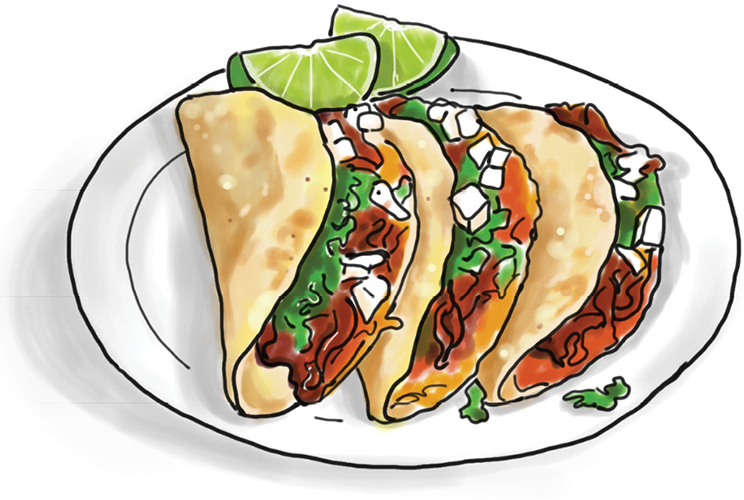
1. Place the beef in a pot with the oregano, peppercorns, clove, salt, and pepper, and add enough water to submerge the meat. Cover and cook on medium heat for 1½ hours, or until the meat is fork-tender.
2. Remove from the heat. Pull apart the meat with a fork and set aside. Transfer all the liquid from the pot into a blender.
3. Heat the oil in a skillet over medium heat and pan-fry the chiles for a few minutes, until they just begin to brown, then transfer to the blender. Add the tomatoes and garlic to the skillet and cook for about 5 minutes, until the garlic is browned and the tomato skin is peeling off. Remove from the heat and peel the tomatoes.
4. Add the garlic and tomatoes to the blender in batches, if necessary, and purée into a uniform sauce.
5. Transfer to a large pot and add the meat. Simmer over medium heat until the liquid is reduced by half, about 20 minutes.
6. Warm the tortillas in a skillet or on a grill. Fill with the meat and garnish with the onion, cilantro, lime, and hot sauce. Serve the consommé together with the tacos or by itself later garnished with cilantro, onions, and lime.
* For a gamier flavor, beef can be replaced (or mixed) with lamb or goat leg and ribs.

CHAMPURRADO
Mexican Hot Chocolate
Makes 8 servings
¼ pound (115 g) piloncillo or panela (unrefined cane sugar) or ½ cup (100 g) granulated sugar
1 cinnamon stick
6 to 8 ounces (170 to 225 g) Mexican drinking chocolate, such as Ibarra or Abuelita brands
2 cups (480 ml) whole milk
¾ cup (90 g) cornmeal
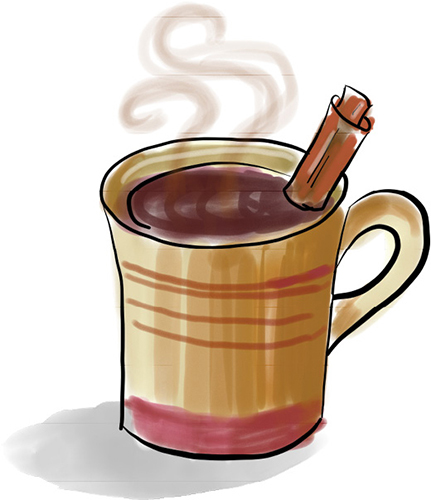
1. Pour 6 cups (1.4 L) water into a large saucepan and add the piloncillo and cinnamon stick. Cook over medium heat until the water starts to boil, then reduce the heat to low and simmer until the piloncillo dissolves, about 10 minutes. (If you use granulated sugar, it will dissolve much faster.)
2. Add the chocolate and cook until the chocolate completely melts, about 5 minutes, stirring occasionally.
3. In a separate bowl, whisk together the milk and cornmeal until thoroughly integrated, creamy, and without lumps. Slowly add the cornmeal mixture to the saucepan, stirring constantly, and ensuring there are no lumps.
4. Turn the heat to medium-high and return to a boil. Reduce the heat to low and simmer, stirring constantly. The liquid will begin to thicken in 6 to 8 minutes. Heat for an additional 5 minutes to cook the cornmeal further, but do not boil for longer than 15 minutes in total, because the beverage will become too thick.
5. Serve in cups or mugs, but be careful as the thick beverage retains a lot of heat! Store leftovers in the refrigerator and drink chilled or reheat to serve hot.